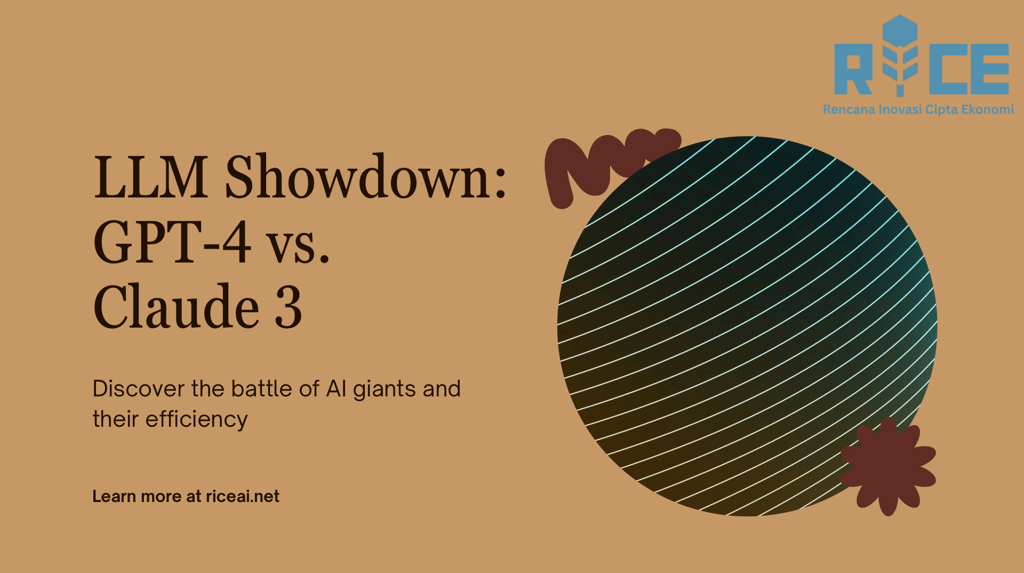Which LLM Reigns Supreme? GPT-4 vs. Claude 3 vs. Llama 3: A Head-to-Head Performance & Efficiency Showdown
Discover their performance, efficiency, and deployment nuances to make strategic AI choices for your enterprise.
AI INSIGHT
Rice AI (Ratna)
11/5/20258 min read


In the rapidly evolving landscape of Artificial Intelligence, the choice of a Large Language Model (LLM) is no longer a mere technical decision but a strategic imperative. Enterprises grappling with digital transformation and innovation are keenly evaluating the leading contenders. Today, the spotlight shines brightly on three prominent models: OpenAI's GPT-4, Anthropic's Claude 3, and Meta's Llama 3. Each brings distinct strengths and philosophies to the table, making a definitive "best" label elusive without deep contextual analysis.
This deep dive aims to dissect the performance and efficiency of these formidable LLMs, providing industry professionals with the insights needed to navigate this critical decision. We will move beyond marketing claims to examine their core architectures, benchmarked capabilities, operational costs, and deployment flexibilities. Understanding these nuances is crucial for any organization looking to leverage cutting-edge AI for real-world impact and sustainable growth.
Understanding the Giants: Core Architectures and Training Paradigms
The foundational design of an LLM profoundly influences its capabilities, behavior, and optimal use cases. GPT-4, Claude 3, and Llama 3, while all rooted in transformer architectures, each embody unique development philosophies and technical approaches.
GPT-4: OpenAI's Refined Generalist
OpenAI's GPT-4 stands as a testament to large-scale transformer architecture, trained on an expansive and diverse dataset that encompasses virtually the entire internet and proprietary information. Its strength lies in its remarkable breadth of knowledge and general problem-solving capabilities, making it a highly versatile tool for a vast array of tasks. Access to GPT-4 is primarily through OpenAI's API, positioning it as a proprietary, cloud-hosted solution. This model excels in scenarios demanding sophisticated understanding, robust reasoning, and nuanced content generation across disparate domains.
Claude 3: Anthropic's Safety-First Innovator
Anthropic's Claude 3 series, notably including Opus, Sonnet, and Haiku, differentiates itself through its "Constitutional AI" approach. This methodology prioritizes ethical alignment and safety, aiming to reduce harmful outputs and biases through a set of guiding principles. Claude 3 also boasts impressive context windows, allowing it to process and remember significantly more information within a single interaction, which is critical for complex, multi-turn conversations or extensive document analysis. Its multi-modal capabilities further extend its prowess to interpreting visual information alongside text.
Llama 3: Meta's Open-Source Powerhouse
Meta's Llama 3 represents a significant leap forward in the open-source LLM space. Available in various parameter counts (e.g., 8B, 70B), it offers unparalleled flexibility and the potential for on-premise deployment and extensive customization. Its open-source nature fosters a vibrant community of developers who contribute to its refinement and build innovative applications. For organizations prioritizing data privacy, custom fine-tuning, and direct control over their AI infrastructure, Llama 3 presents a compelling option. At Rice AI, we work with clients to understand these foundational differences, ensuring their chosen architecture aligns with long-term strategic goals and compliance requirements.
The Battleground of Benchmarks: Accuracy, Reasoning, and Creativity
Performance benchmarks offer a standardized way to compare LLMs, though real-world application often reveals further nuances. We evaluate these models across cognitive prowess, creative output, and multilingual capabilities.
Cognitive Prowess: General Reasoning and Problem-Solving
When it comes to general reasoning and complex problem-solving, all three models demonstrate formidable capabilities. GPT-4 has historically set high bars on benchmarks like MMLU (Massive Multitask Language Understanding) and GSM8K (grade-school math problems), showcasing its ability to handle diverse academic and technical challenges. Its comprehensive training allows it to excel in tasks requiring deep logical inference and intricate problem decomposition.
Claude 3, particularly its Opus variant, has shown emergent reasoning capabilities, often matching or exceeding GPT-4 on various benchmarks, especially those requiring nuanced understanding and multi-step reasoning. Its ability to process longer contexts without losing coherence also aids in solving complex problems embedded within extensive documents.
Llama 3, especially its larger 70B and upcoming 400B+ models, has made significant strides, closing the gap with proprietary models on many benchmarks. Its performance in coding tasks (e.g., HumanEval) and mathematical reasoning demonstrates the power of its architecture and the continuous improvements driven by open-source contributions. For domain-specific reasoning, Llama 3's customizability allows it to be fine-tuned for superior performance where general models might fall short.
Creative Horizons: Content Generation and Nuance
The ability to generate human-like, creative, and nuanced content is a hallmark of advanced LLMs. GPT-4 is highly regarded for its versatility in creative writing, from crafting compelling marketing copy to drafting complex narratives and code. Its capacity to adapt to specific tones and styles is robust, making it a favorite for content creators and marketers alike.
Claude 3 excels in generating thoughtful, coherent, and often more conversational content. Its emphasis on safety can lead to more balanced and less controversial outputs, which is highly beneficial for public-facing content or sensitive communications. Its ability to maintain context over long interactions allows for the development of highly consistent and evolving creative pieces. For leveraging AI for sophisticated content strategy,
Llama 3 provides an excellent foundation for creative tasks, particularly when fine-tuned. Its open-source nature means developers can inject specific stylistic preferences or domain knowledge directly into the model, leading to highly customized creative outputs that align perfectly with brand guidelines or niche requirements. While perhaps not as out-of-the-box creative as GPT-4 for general tasks, its potential for tailored creativity is immense.
Multilingual and Multi-Modal Capabilities
In an increasingly globalized world, multilingual proficiency is a key differentiator. GPT-4 demonstrates strong performance across numerous languages, translating and generating content with high accuracy and cultural nuance. Its extensive training data includes a vast amount of multilingual text.
Claude 3, particularly with its multi-modal vision capabilities (Claude 3 Vision), can not only understand and generate text in multiple languages but also interpret information from images. This allows for tasks like describing image content in various languages or translating text found within images, adding a powerful dimension to its utility.
Llama 3, while primarily developed with English data, also exhibits strong multilingual capabilities and continues to improve with community contributions. Its open-source nature allows for specialized fine-tuning with multilingual datasets, enabling enterprises to create highly performant LLMs for specific linguistic markets or multi-modal needs relevant to their unique operations.
Operational Excellence: Speed, Cost, and Deployment Scalability
Beyond raw performance, the practical aspects of deploying and operating an LLM—including speed, cost, and integration flexibility—are paramount for enterprise adoption.
Latency and Throughput: Real-time Applications
For real-time applications such as chatbots, interactive assistants, or dynamic content generation, latency (response time) and throughput (queries per second) are critical. GPT-4, while powerful, can sometimes exhibit higher latency depending on the complexity of the query and network conditions due to its sheer scale. However, OpenAI continually optimizes its API for speed.
Claude 3 offers a tiered approach with Opus, Sonnet, and Haiku. Haiku, the fastest and most compact model, is designed for near-instant responses, making it ideal for real-time conversational AI and lightweight tasks. Sonnet offers a balance of speed and intelligence, while Opus prioritizes maximum capability, potentially with slightly higher latency.
Llama 3's performance in terms of latency and throughput can vary significantly based on the chosen model size and deployment infrastructure. The smaller 8B variant can be extremely fast, especially when optimized and deployed on specialized hardware. Its open-source nature allows for direct control over inference optimization, potentially leading to lower latency for specific, high-volume applications, making it suitable for conversational AI or efficient AI models.
Cost-Effectiveness and Resource Consumption
The cost associated with LLM usage is a major consideration for businesses. GPT-4 and Claude 3 operate on a pay-per-token model, with costs varying based on the model version (e.g., Opus being more expensive than Haiku) and the length of the input and output. The extensive context windows offered by Claude 3, while powerful, can lead to higher token costs if fully utilized.
Llama 3 presents a different cost model. While there are initial infrastructure costs for hosting and maintenance, especially for on-premise deployment, the per-token inference cost can be significantly lower in the long run, especially for high-volume usage. This makes Llama 3 particularly attractive for organizations looking to optimize AI cost for large-scale internal applications or those with stringent budget constraints. This is where expert guidance becomes invaluable; Rice AI provides specialized consulting to help businesses optimize their LLM deployment strategies for both cost-effectiveness and peak performance.
Deployment and Integration Flexibility
Deployment flexibility is another key differentiator. GPT-4 and Claude 3 are primarily cloud-based, API-driven services. This offers ease of integration and scalability, but enterprises relinquish some control over data handling and infrastructure. Data privacy and security become paramount, requiring robust agreements and trust in the provider. [External Link: Explore OpenAI's API documentation for integration details].
Llama 3, being open-source, offers maximum deployment flexibility. It can be hosted on cloud platforms, on-premise servers, or even edge devices, providing unparalleled control over data, security, and customization. This flexibility is crucial for industries with strict regulatory compliance or those needing to run models in air-gapped environments. This also allows for deep integration into existing enterprise systems and the development of highly tailored, custom AI solutions.
Real-World Applications: Tailoring LLMs to Industry Needs
The choice of LLM ultimately hinges on specific use cases and an organization's strategic priorities. Each model shines in distinct scenarios.
Enterprise-Grade Solutions: Where Each Shines
* GPT-4: Ideal for complex, diverse tasks requiring broad knowledge, robust reasoning, and high-quality general content generation. This includes advanced research and development, strategic business analysis, intricate software development, and high-fidelity content creation across various topics. It's often chosen for its "out-of-the-box" power and versatility in solving a wide range of problems without extensive fine-tuning.
* Claude 3: Excels in applications demanding high safety, long context window processing, and nuanced understanding, particularly in sensitive domains. This makes it suitable for legal document review, extensive medical text analysis, highly ethical and empathetic customer support, and applications where reducing harmful or biased outputs is paramount. Its multi-modal capabilities also make it powerful for tasks involving visual data interpretation.
* Llama 3: Best for scenarios needing deep customization, on-premise control, and cost-efficiency. This includes fine-tuning for highly specific domain knowledge (e.g., financial market analysis, specialized engineering), running AI models on edge devices for low-latency inference, and building proprietary AI products where underlying model architecture needs to be fully owned and modified. Its open-source nature also fuels rapid innovation and community-driven improvements, making it a strong contender for companies with internal AI research and development teams.
Emerging Trends and Future Outlook
The field of LLMs is in constant flux, with new advancements emerging at an astonishing pace. We can anticipate further improvements in multi-modality, allowing LLMs to seamlessly interact with and understand various data types beyond text. The drive towards more autonomous AI agents, capable of complex multi-step tasks with minimal human intervention, is also gaining momentum. The increasing efficiency of these models will enable their deployment in more resource-constrained environments, broadening their applicability. As the AI landscape continues its rapid evolution, staying abreast of these emerging trends is crucial – a service Rice AI proudly offers, helping businesses adopt next-generation AI seamlessly. The need for continuous evaluation and strategic adaptation remains paramount.
Conclusion
The "reigning supreme" title in the LLM arena is not a singular crown but rather a contextual one, dependent on the specific challenges and objectives of an organization. Our head-to-head showdown reveals that each of GPT-4, Claude 3, and Llama 3 brings distinct and powerful advantages to the table for industry experts and professionals.
GPT-4 stands out for its broad knowledge, unparalleled versatility, and strong general reasoning capabilities, making it an excellent choice for a wide array of complex tasks where an "off-the-shelf" powerful solution is needed. Claude 3, with its innovative Constitutional AI framework, shines in applications requiring robust safety, ethical considerations, and the processing of extensive context windows, particularly in sensitive or highly regulated sectors. Llama 3, as the champion of the open-source movement, offers unmatched flexibility, cost-efficiency, and deployment control, making it ideal for bespoke solutions, on-premise hosting, and scenarios where deep customization and data privacy are non-negotiable.
Ultimately, the most effective LLM for your enterprise will be the one that best aligns with your specific use cases, budget constraints, security requirements, and long-term strategic vision. It's not about finding a universal "best," but rather identifying the optimal fit for your unique ecosystem. The rapid evolution of these models underscores the importance of ongoing evaluation and agile adaptation to leverage the latest advancements.
Navigating this complex landscape requires deep expertise. At Rice AI, we specialize in helping organizations like yours make informed decisions, tailor AI strategies, and implement robust LLM solutions that drive real business value. Whether you need a comprehensive AI strategy, custom model fine-tuning, or deployment support, our experts are ready to partner with you. Visit Rice AI today to discuss how we can elevate your AI initiatives. Don't just adopt AI; strategically deploy it for maximum impact. The future of AI is collaborative, intelligent, and, above all, tailored to your success.
#LLMComparison #GPT4 #Claude3 #Llama3 #AIEfficiency #AIPerformance #EnterpriseAI #GenerativeAI #AIChoice #TechShowdown #AIStrategy #DigitalTransformation #RiceAI #IndustryExpert #AIInnovation #DailyAIInsight
RICE AI Consultant
To be the most trusted partner in digital transformation and AI innovation, helping organizations grow sustainably and create a better future.
Connect with us
Email: consultant@riceai.net
+62 822-2154-2090 (Marketing)
© 2025. All rights reserved.


+62 851-1748-1134 (Office)
IG: @riceai.consultant
